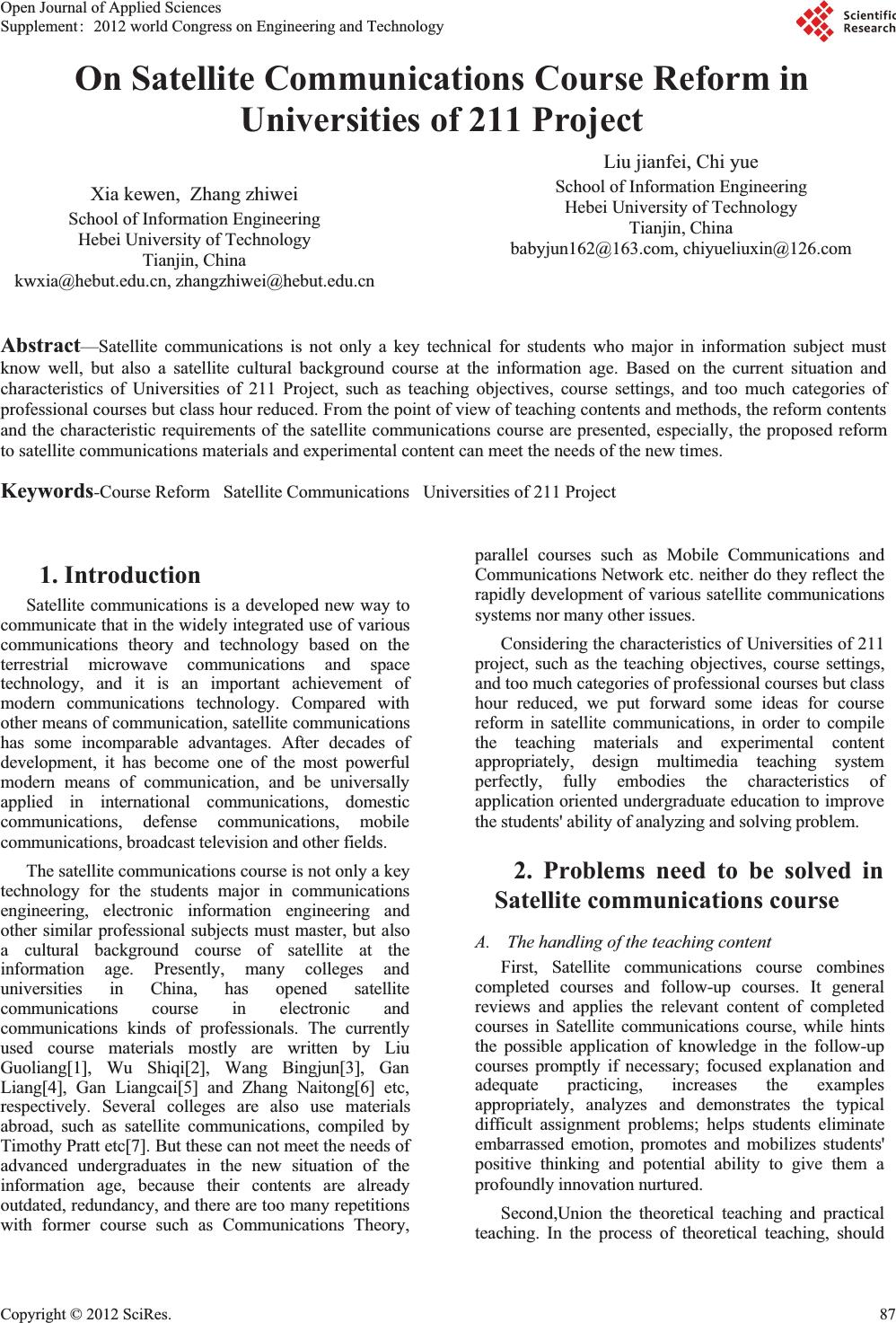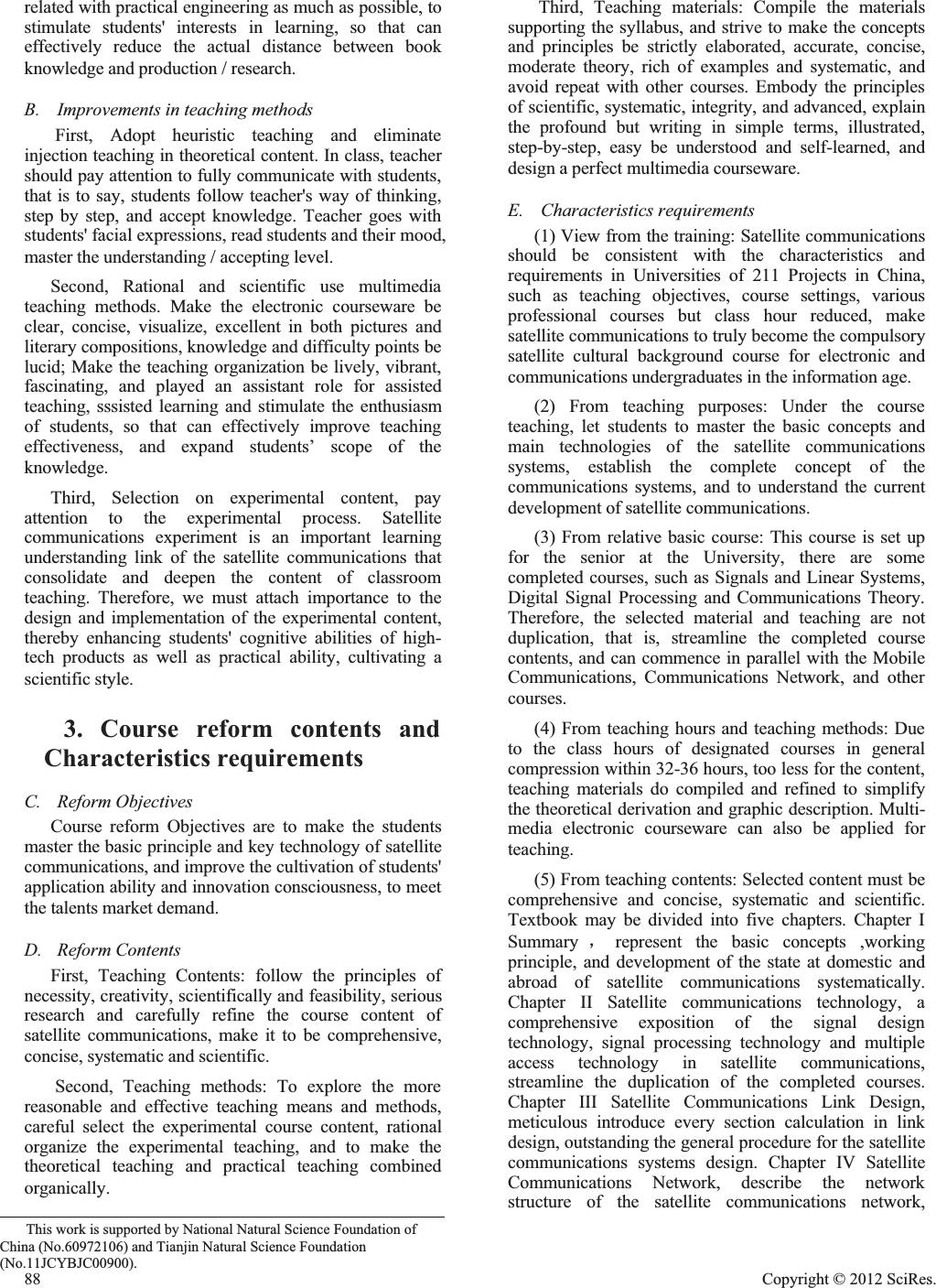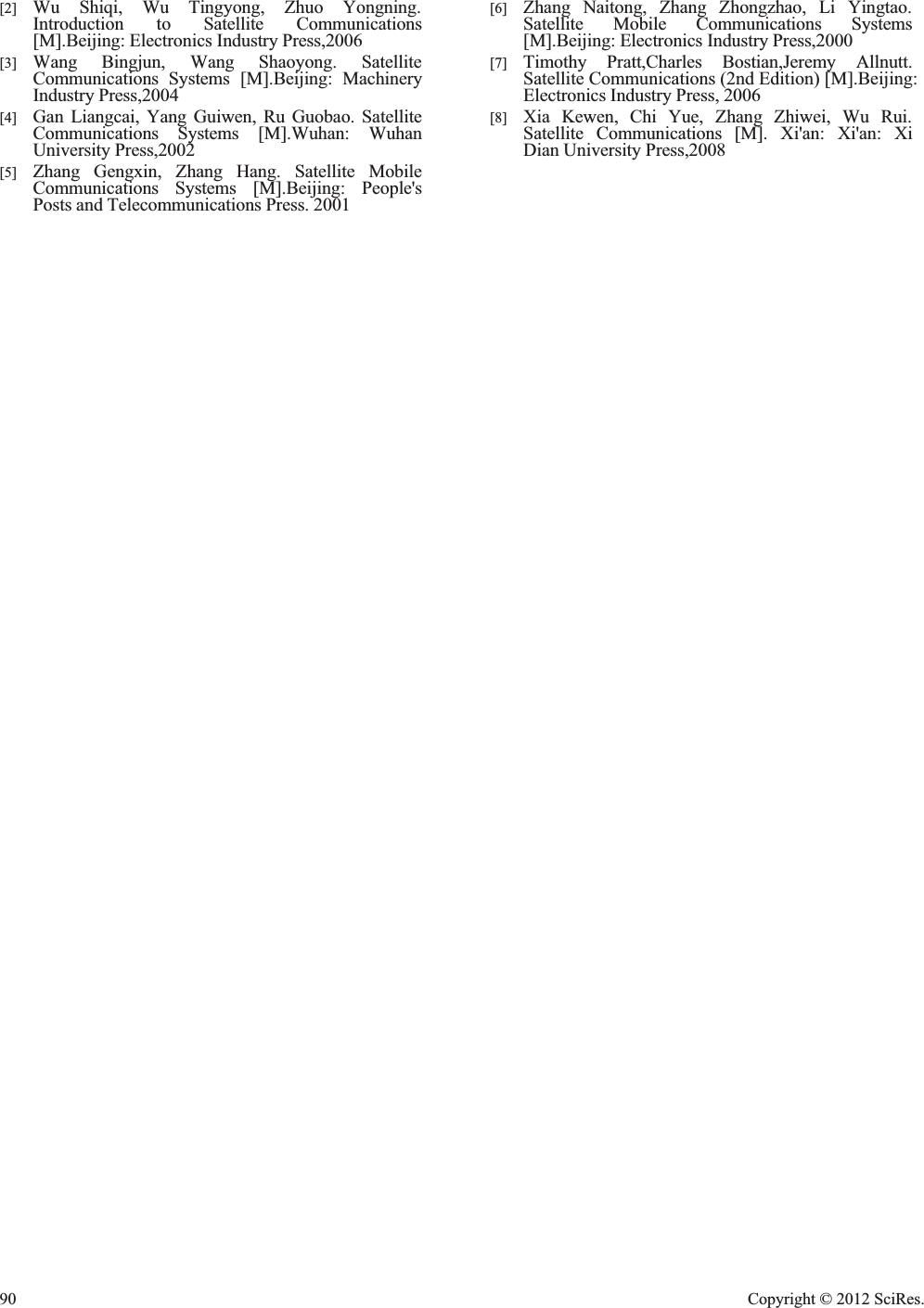Paper Menu >>
Journal Menu >>
 On Satellite Communications Course Reform in Universities of 211 Project Xia kewen,Zhang zhiwei School of Information Engineering Hebei University of Technology Tianjin, China kwxia@hebut.edu.cn, zhangzhiwei@hebut.edu.cn Liu jianfei, Chi yue School of Information Engineering Hebei University of Technology Tianjin, China babyjun162@163.com, chiyueliuxin@126.com Abstract—Satellite communications is not only a key technical for students who major in information subject must know well, but also a satellitecultural background course at the information age. Based on the currentsituation and characteristics of Universities of 211 Project, such as teaching objectives,course settings, and too much categories of professional courses but class hour reduced. From the point of view of teaching contents and methods, the reform contents and the characteristic requirements of the satellite communications course are presented, especially, the proposed reform to satellite communications materials and experimental content can meet the needsof the new times. Keywords-Course ReformSatellite CommunicationsUniversities of 211 Project 1. Introduction Satellite communications is a developed new way to communicate that in the widely integrated use of various communications theory and technology based on the terrestrial microwave communications and space technology, and it is animportant achievement of modern communications technology. Compared with other meansof communication,satellite communications has someincomparable advantages.Afterdecadesof development, it has become one of the most powerful modern means of communication, and be universally applied in international communications, domestic communications, defensecommunications, mobile communications, broadcasttelevision andother fields. The satellite communications courseis not only a key technology forthe students majorin communications engineering, electronic information engineering and other similar professional subjects must master, but also a cultural background courseof satellite at the information age. Presently, many colleges and universities in China, has opened satellite communications course in electronic and communications kinds of professionals. The currently used course materials mostly are writtenbyLiu Guoliang[1], Wu Shiqi[2], Wang Bingjun[3], Gan Liang[4], GanLiangcai[5]andZhang Naitong[6]etc, respectively. Severalcolleges are alsouse materials abroad, such as satellite communications, compiled by Timothy Pratt etc[7]. But these can not meet the needs of advanced undergraduates inthe new situationof the information age, because their contents are already outdated, redundancy, and there are too many repetitions with former course such as Communications Theory, parallel courses such asMobile Communicationsand Communications Network etc. neither do they reflect the rapidly developmentof various satellitecommunications systems nor many other issues. Considering the characteristics of Universitiesof 211 project, such as the teaching objectives, course settings, and too much categoriesof professional courses but class hour reduced,we putforward some ideasfor course reform insatellite communications,in order tocompile the teaching materials and experimental content appropriately, design multimediateaching system perfectly, fully embodies the characteristics of application oriented undergraduateeducation to improve the students' ability of analyzing and solving problem. 2. Problems needto be solved in Satellite communications course A.The handling of the teaching content First, Satellite communications coursecombines completed courses and follow-up courses. It general reviews and applies the relevant content of completed courses in Satellite communications course, while hints the possible application of knowledge in thefollow-up courses promptly if necessary;focused explanation and adequate practicing, increases the examples appropriately, analyzes and demonstrates the typical difficult assignmentproblems; helps students eliminate embarrassed emotion, promotes and mobilizes students' positive thinking and potential ability to give thema profoundly innovationnurtured. Second,Union thetheoretical teaching and practical teaching. Inthe process of theoreticalteaching, should Open Journal of Applied Sciences Supplement:2012 world Congress on Engineering and Technology Cop y ri g ht © 2012 SciRes.87  related withpractical engineeringas much as possible, to stimulate students'interests inlearning, sothat can effectively reducethe actualdistance betweenbook knowledge and production / research. B.Improvements in teaching methods First, Adopt heuristic teaching and eliminate injection teaching in theoretical content. In class, teacher should pay attention to fully communicate with students, that istosay, studentsfollowteacher's way ofthinking, step by step,and acceptknowledge. Teachergoes with students' facial expressions, read students and their mood, master the understanding / accepting level. Second, Rational and scientific use multimedia teaching methods. Make the electronic courseware be clear, concise, visualize, excellent in both pictures and literary compositions, knowledge and difficultypoints be lucid; Make the teaching organization be lively, vibrant, fascinating, andplayed an assistantrole forassisted teaching,sssisted learningand stimulatetheenthusiasm of students,so that can effectivelyimprove teaching effectiveness, and expand students’ scope of the knowledge. Third, Selection onexperimental content, pay attention to the experimental process. Satellite communications experiment is an important learning understanding link of the satellitecommunications that consolidate and deepen the content of classroom teaching. Therefore, we must attachimportance to the design and implementation of the experimental content, thereby enhancing students' cognitive abilities of high- tech products aswellas practicalability,cultivatinga scientific style. 3. Course reform contents and Characteristics requirements C.Reform Objectives Course reform Objectives areto make the students master the basic principle and key technologyof satellite communications, and improve the cultivation of students' applicationability and innovationconsciousness, tomeet the talents market demand. D.ReformContents First, TeachingContents: follow theprinciples of necessity, creativity, scientifically and feasibility, serious research andcarefully refinethe coursecontent of satellite communications, makeit to be comprehensive, concise, systematic and scientific. Second,Teachingmethods: Toexplorethe more reasonable and effective teaching means and methods, careful select the experimental course content, rational organize theexperimental teaching, andtomake the theoretical teachingand practicalteaching combined organically. Third, Teaching materials: Compile the materials supporting the syllabus,and strive to make the concepts and principles bestrictly elaborated,accurate,concise, moderate theory, rich of examples and systematic, and avoid repeat withother courses. Embody the principles of scientific, systematic, integrity, and advanced, explain the profound but writing in simple terms, illustrated, step-by-step, easybe understoodand self-learned, and design a perfect multimedia courseware. E.Characteristics requirements (1) View from the training: Satellite communications should be consistent with thecharacteristics and requirements in Universities of 211 Projectsin China, such as teaching objectives, coursesettings, various professional courses but classhour reduced, make satellite communications to truly become the compulsory satellite cultural background coursefor electronic and communications undergraduates in the information age. (2) From teaching purposes: Under the course teaching, let students tomaster the basic concepts and main technologiesof the satellitecommunications systems, establishthe completeconcept of the communicationssystems, andto understand the current development of satellite communications. (3) Fromrelativebasic course: Thiscourse issetup for thesenior atthe University,thereare some completed courses, such as Signals and Linear Systems, Digital Signal Processingand CommunicationsTheory. Therefore, the selected material and teaching are not duplication, that is,streamline thecompleted course contents, and cancommence in parallel with the Mobile Communications,CommunicationsNetwork,and other courses. (4) Fromteachinghours and teachingmethods:Due to the class hours ofdesignatedcourses ingeneral compression within32-36 hours,too less for the content, teaching materialsdo compiled andrefined to simplify the theoretical derivation and graphic description. Multi- media electronic courseware can alsobe appliedfor teaching. (5) From teaching contents: Selected content must be comprehensive and concise, systematic and scientific. Textbook maybe divided into five chapters.Chapter I Summary ˈrepresent the basic concepts,working principle, and development ofthe state at domesticand abroad of satellite communications systematically. Chapter II Satellite communications technology, a comprehensive expositionof the signal design technology, signal processingtechnology and multiple access technology in satellite communications, streamline theduplicationof the completed courses. Chapter IIISatelliteCommunicationsLinkDesign, meticulousintroduce everysectioncalculationin link design, outstanding the general procedure for the satellite communicationssystems design.ChapterIV Satellite CommunicationsNetwork, describe the network structure of the satellite communications network, This work is supported by National Natural Science Foundation of China (No.60972106)andTianjinNatural Science Foundation (No.11JCYBJC00900). 88 Cop y ri g ht © 2012 SciRes.  terrestrial communications network links, and VSAT satellite communications network, highlighting the complete conception of communicationssystems. Chapter VMobileSatellite CommunicationsSystems, introduce a variety of new mobile satellite communicationssystems and developments, in orderto reach the purpose ofopen eyes andimprove innovation sense. To this end, we accumulated long-term experience in teaching, and applied it in satellite communications teaching materials preparationfor Universitiesof 211 Project [8],its contentof teaching arrangementsshown in Table 1.At present, this publishedtextbook is widely used in countrywide and gets avery good affection feedback. (6) From the experimental content arrangements: Experiment is an important understanding session of learning satellite communications,which can help students to consolidate and deepen the content of classroom teaching,enhance students' cognitiveand practical abilities of high-tech products, andfoster a scientific style. Therefore, we must attach importance to the experimental design and implementation in the course. if experimental coursescan be set to 6-8 hours, for example, can be arranged in accordance with Table 2 shows, thecontentof these experimentsenablestudents to master the debugging of satellite signals, installation of satelliteantenna, aswell assatellite positioning technology. TABLE I.CLASSROOM TEACHING CONTENT FOR SATELLITE TABLE II.EXPERIMENTAL CONTENT OF SATELLITE COMMUNICATIONS 4. Summary Considering the Universities of 211 Project’s teaching objectives, course settings, and too much categories of professional courses butclass hours reduced, we must explorethebetter suitable teaching contents and methods for undergraduates, and organize experimental teachingrationally,make thetheoretical teaching and practical teaching combined organically. Appropriate coursematerials, well-designedmultimedia teaching systemsandexplore a more rationaland effective teaching means and methods are necessary. In orderto enablestudents tomasterthe basicprinciples of satellite communications,key technologies, and its developmenttrend, we must strengthen thecultivation of students' application skills and sense of innovation, to accommodate the demands of today's talentmarket. 5. Acknowledgment Acknowledgments:This work issupportedby National NaturalScienceFoundation ofChina (No.60972106) and Tianjin Natural ScienceFoundation (No.11JCYBJC00900). REFERENCES [1] Liu Guolian g ,Ron g Kunbi. Satellite Communications [ M ] . Xi'an: Xi DianUniversit y Press, 2004 Chapter Abstract 1. Summary1.1Basicconceptsandcharacteristicsof Satellite communications; 1.2 Ground radio station;1.3 Communications satellite; 1.4Radiowaves propagationand working frequency-band; 1.5 Developments of satellite communications 2.Satellite Communications Technology 2.1 Signal design technology (modulation and coding); 2.2 Signal processing technology; 2.3 Multiple access technology 3.Satellite Communications Link Design 3.1 CNRin receiverinput; 3.2 C/Tvalue of Satellite communications link; 3.3 Calculation ondigital satellite communications link 4.Satellite Communications Network, 4.1Network structure;4.2 Connection between Satellite Communications Network and Ground-based communications network; 4.3 VSAT satellite communications Network; 4.4 Typical satellite communications Network Systems 5.Mobile Satellite Communications Systems 5.1 International mobile satellite communications systems; 5.2 Geo stationary regionalmobile satellite communicationssystems; 5.3 Low earth orbit mobile satellite communications systems; 5.4 Medium earth orbit mobile satellite communicationssystems; 5.5 Satellite navigation and positioning systems No. Experiment name Experimental content and requirements 1 Installation on satellite receiver antenna systems Master antenna installation, antenna angle designand antenna directionselection in satellite receiver 2 Satellite receiver debuggingand site debugging Master thesignals receiving method in satellite receiver, and familiar withthe reception debugging 3 Installation and debugging on Satellite IP receiver assemble Master the installation, use, and receivingprocess debugging ofSatellite IP receiver 4 Satellite position trackingand memory setting Use locatorto track satellite and set location memory Cop y ri g ht © 2012 SciRes.89  [2] Wu Shi q i, Wu Tin gy on g , Zhuo Yon g nin g . Introduction to Satellite Communications [M].Beijing: Electronics Industr y Press,2006 [3] Wan g Bin gj un, Wan g Shao y on g . Satellite Communications S y stems [ M ] .Bei j in g : Machiner y Industr y Press,2004 [4] Gan Lian g cai, Yan g Guiwen, RuGuobao. Satellite Communications S y stems [ M ] .Wuhan: Wuhan University Press,2002 [5] Zhan g Gen g xin, Zhan g Han g . SatelliteMobile CommunicationsS y stems [ M ] .Bei j in g :Peo p le's Posts an d Telecommunications Press. 2001 [6] Zhan g N aiton g ,Zhan g Zhon g zhao, Li Yin g tao. Satellite Mobile Communications S y stems [M].Beijing: Electronics Industr y Press,2000 [7] Timoth y Pratt,Charles Bostian,Jerem y Allnutt. Satellite Communications ( 2n d Edition ) [ M ] .Bei j in g : Electronics Industr y Press, 2006 [8] Xia Kewen, Chi Yue, Zhan g Zhiwei, Wu Rui. Satellite Communications [ M ] . Xi'an: Xi'an: Xi Dian University Press,2008 90 Cop y ri g ht © 2012 SciRes. |

